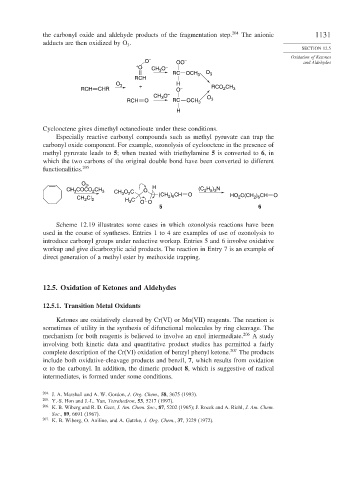Page 1155 - Advanced Organic Chemistry Part B - Reactions & Synthesis
P. 1155
the carbonyl oxide and aldehyde products of the fragmentation step. 204 The anionic 1131
adducts are then oxidized by O .
3
SECTION 12.5
Oxidation of Ketones
O – OO – and Aldehydes
+ O CH O –
3
RC OCH 3 O 3
RCH
O 3 H
RCH CHR + O – RCO CH 3
2
CH O – O
3
RCH O RC OCH 3 3
H
Cyclooctene gives dimethyl octanedioate under these conditions.
Especially reactive carbonyl compounds such as methyl pyruvate can trap the
carbonyl oxide component. For example, ozonolysis of cyclooctene in the presence of
methyl pyruvate leads to 5; when treated with triethylamine 5 is converted to 6,in
which the two carbons of the original double bond have been converted to different
functionalities. 205
O ,
3
CH COCO CH 3 CH O C O H (C H ) N
2 5 3
2
3
3
2
2 6
2 6
CH Cl 2 H C O O (CH ) CH O HO 2 C(CH ) CH O
2
3
5 6
Scheme 12.19 illustrates some cases in which ozonolysis reactions have been
used in the course of syntheses. Entries 1 to 4 are examples of use of ozonolysis to
introduce carbonyl groups under reductive workup. Entries 5 and 6 involve oxidative
workup and give dicarboxylic acid products. The reaction in Entry 7 is an example of
direct generation of a methyl ester by methoxide trapping.
12.5. Oxidation of Ketones and Aldehydes
12.5.1. Transition Metal Oxidants
Ketones are oxidatively cleaved by Cr(VI) or Mn(VII) reagents. The reaction is
sometimes of utility in the synthesis of difunctional molecules by ring cleavage. The
mechanism for both reagents is believed to involve an enol intermediate. 206 A study
involving both kinetic data and quantitative product studies has permitted a fairly
complete description of the Cr(VI) oxidation of benzyl phenyl ketone. 207 The products
include both oxidative-cleavage products and benzil, 7, which results from oxidation
to the carbonyl. In addition, the dimeric product 8, which is suggestive of radical
intermediates, is formed under some conditions.
204
J. A. Marshall and A. W. Gordon, J. Org. Chem., 58, 3675 (1993).
205 Y.-S. Hon and J.-L. Yan, Tetrahedron, 53, 5217 (1997).
206 K. B. Wiberg and R. D. Geer, J. Am. Chem. Soc., 87, 5202 (1965); J. Rocek and A. Riehl, J. Am. Chem.
Soc., 89, 6691 (1967).
207
K. B. Wiberg, O. Aniline, and A. Gatzke, J. Org. Chem., 37, 3229 (1972).

